|
|

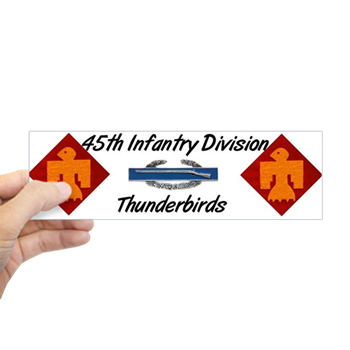
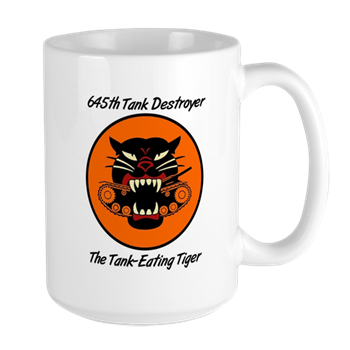
KREIGSERINNERUNGEN
|
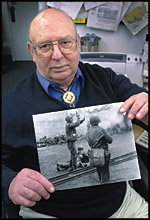 |
|
David
Isreal |
A self explanatory E-mail letter sent to Albert Panebianco by David Israel. Dave Israel served as an army investigator at the Dachau concentration Camp after the hostilities ceased in the summer of 1945. At this date [6 September 2003] Al is recovering from a serious heart operation. He was one of the members of the 3rd Battalion,157th Infantry Regiment who were the 'liberators' of the infamous Dachau Concentration Camp in Germany.
Al: Thinking of you.
Hi!:
It is 4am. Unable to sleep my mind just drifted to a friend here at the old age home who just turned 80 and is depressed. Long days, longer hours with nothing to do can be devastating. I advised him to think of the happy times in his life and to put those happy time thoughts down in writing. From there he can think of other good things that happened in his life and go on from there. Tonite, at dinner he thanked me and told me that he was enjoying putting those happy time thoughts on paper.
My mind must have been in that mode. Unable to sleep, I thought of things that have given me pleasure over the past few years..... and at the top of the list was meeting, talking and writing to a group of guys I met very late in life who have one common denominator. I don't have any idea what the religion of most of them is, or if they even believe in any special religion. From time to time I get an inkling of their political feelings and thoughts, but those thoughts have little or nothing to do with our relationship. The one big factor we share is our willingness to share thoughts and experiences in which we have some shreds of sameness. We have all been brought up in The American culture. All schooled here, married, had kids, faced the trials and tribulations of them growing up in such a rapidly changing society that we've had trouble keeping up with the language, music and mores that they take for granted. When it comes to military service, again, we've all had different and varied experiences stretching out over different amounts of time, but that same willingness to share experiences prevails, and it is beautiful. I made it my business to go to Washington, Los Angeles, Houston, Philly, Vermont and Dachau to meet and spend time with the guys who did the thing. I met with guys from the 42nd, the Japanese American 522nd, the 99th division the 87th and most of all the men of Sparks' outfit the 157th. I remember being in the hospitality suites at reunions of the 45th and 42nd guys and thinking to myself.....Jesus, these guys are all 75 to 85 years old......they must be on medications of some kind or other as I am, how they hell can they sit here smoking and drinking like this....hour after hour.....looking through Foster's archives or admiring his collection of WWII memorabilia. (I never did find out the answer to that question of how they do it.) At all the reunions, even at the Japanese American one.....guys who rarely talk, especially to strangers, opened up and shared as if we had been brothers in the same god damned foxhole.....no, that's wrong....closer than brothers
I remember sitting with Sparks, and Bill Walsh and John Lee and Ed Gorak from Chicago who sang the Polish National anthem with the Polish priests in Dachau, and Chaplain Loy's French wife and Fink and I don't recall how many others just sitting around coffeeing and enjoying being in each other's company. I remember showing some of my stuff to Birdseye and another group when suddenly he burst out of the room in tears....he couldn't take the depth of his memories at that moment. His wife later wrote to me, sharing some of his letters. The women of these men, like Ruth Walsh, my wife, Ann Bird and Ruth Whiteway were all part of this sharing.....they've lived with these stories for many years. I can't forget the sharing Curt Whiteway and I experienced with Barbara Distel.....curator of the Dachau Museum in Dachau in 1995....the fiftieth anniversary of the Liberation or how Curt and I felt after talking to senior students at the high school in Dachau when they all knocked on their desks with their fists which was their way of applauding our talk to them. This was their way of sharing and showing their appreciation to American GI's for having made Germany and their way of life what it is today, rather than what it would have been under Hitler.
I remember well the sharing with Art Lee when he dug up some piece of information from 50 years ago which he happily sent along to me.....and talking to Russ and Jim Bird about their extensive war time memories.
I remember talking to survivors, who broke down when telling me about cannibalism on the death trains and one who became the chief librarian at City College in New York who had worked in the gas chambers and ovens of Dachau. He sent me a detailed map he had kept which indicated every stone in the area......he had been allowed in and out because he was on the repair detail.
I remember Don Downard's voice as he thanked me for digging up information he was interested in. He was, like Sparks, a fighting Lt. Col. He was the officer pictured in many books and magazines holding the one live survivor of the death train at Dachau. Tony Cardinale, the GI who found the lone survivor came that close to being famous...his arm was in the picture....but not his face. I spoke to John DeGro the first GI into Dachau....he was blind and pretty deaf at the time, but his daughter was on the line with us and helped the conversation along. Hank Mills was in an I&R jeep approaching the front gate of the camp when shots rang out. He swears the krauts could have killed the guys in the jeep had they wanted to. He too had great difficulty talking about things back then, but to his credit he did. Jim Creasman of Arizona wrote about what happened in Dachau. He was a Sgt. till his article came out. The next day he was a Lt. by order of the CO of the 42nd division. And I will never forget the elation in Art Lee's voice when I told him we had finally tracked down Peter Furst.....the reporter for S&S who drove in with Marguerite Higgins. And how about Sparks when he saw those four photos we dug up....still in the photographers can.....in a garage in Highland Park NJ showing Sparks with his 45 in the air stopping the shooting at the wall. Four photos which proved beyond a shadow of a doubt that Sparks' story was correct. What a day that was.....as well as the day in Orlando when Dan Dougherty showed those photos during his slide presentation. WOW!
Sharing has been the key to my completing my book which will be titled: The Day The Thunderbird Cried.
I will be sending all of you who shared with me, a copy of the book when printed, but I would like to thank you all for the wonderful experience of sharing and spending time either personally or on the phone or on the computer. I treasure the memories and experiences we shared together (and even some of Hugh Foster's rye jokes). I treasure Foster telling me about his dad who trained the Indian code talkers used in Europe that no one ever hears of....not the Navajos of the Pacific.....but the ones that were vital to getting out quick and accurate messages in the ETO. I treasure the materials his dad sent me which he developed for training the native Americans. Imagine!!!!! a General writing to me....sharing his war time experiences. I'm also reminded of the time Sparks gave his memorable speech at the Holocaust Museum in Washington. Let these revisionists who say it never happened tell ME it never happened, he said. His meaning was clear, let these revisionist mothers peddle their garbage elsewhere but not to the guys who were in Germany in 44 and 45. Sparks in his eighties was still a man to be reckoned with. I recall just how many men from the 157th spoke affectionately about Sparks and his concern for his men. "Sparks" they said " is a soldier's soldier".
I remember meeting E.G. McConnell in Washington. He was a member of the black 761st Tank Battalion, the one PBS said liberated Buchenwald and Dachau. Turned out he went to the same high school I did, Boys High in Brooklyn. He said he and the other guys were paid $12000 to say they were in Buchenwald and Dachau.....that none of it was true. I wrote to PBS in New York and got a 3 page letter of apology saying they just hadn't done their homework. Their military historian Robert Abzug of Texas wrote to me as well saying they used his name without his permission both in the book the Black Liberators and the PBS production of the same name. E/G. later instituted a lawsuit against Nina Rosenberg but I don't remember what the outcome was.....if any. ( Her dad had been a member of the 163 Photographic unit taking pictures of what was going on in Dachau on April 29th, including the scenes at the wall. I remember meeting Al Panebianco at the reunion in Philly and how we hit it off immediately. Unfortunately he wasn't feeling too well and had to leave early. We have conversed over the wire many times since then about his moving to N.C. etc. and I was able to put him in touch with Tony Cardinale of the 42nd who also moved to N.C. They met several times and have become fast friends. Tony is known as the Italian Nightingale and at the drop of a hat will take you back to 1944 with one of the old standards. Winfield Rosenberg was from Lewes Delaware, the same town John Lee lived in. Winfield was one of those guys taken out of a POW camp and sent to Berga, a sub camp of Buchenwald. The krauts wanted 350 Jewish GI's for this job but only got about 80. The other guys picked either looked Jewish, or had Jewish sounding names or were troublemakers of one kind or another. In the concentration camp for about 4 months, 70 of the group died before being liberated. For almost 50 years the State Department and the Pentagon said "it never happened.....the Germans did not put GIs into regular concentration camps." Then suddenly the German Government admitted it did happen and the Pentagon changed its mind and said yes it did happen. A young attorney sued the German Government in a class action lawsuit and beat the bastards. I had put Winfield in touch with the attorney. In the interim he died, but his wife was able to collect $90,000 for the time he was in Berga and the injuries he sustained there. All because John Lee thought it would be a good idea to introduce us. Ironically, John Lee's brother in law was one of those revisionists who insisted the Holocaust never happened. Used to drive John Lee nuts. John was the B.A.R. man in the famous picture of liberation day "at the wall" And I also thank Mel Rappaport who sends cutouts of the NY press with stories about WWII and the outfits who did what they did when it was needed. He was with the 6th armored division which relieved Bostogne....of "NUTS" fame.
I will never forget Gen. Patch's daughter who told me of the last letter she received from her dad in which he paid tribute to the men of the Seventh Army. "Where did we get such men" she said her father asked, "Where did we get such men?" Patch was not like General Patton who loved war. Patch was one of those guys who got the job done without a PR team surrounding him. He was one of those Generals who thought War was Hell. Pure insanity.
I thank you all for your friendship and your generous sharing.
Sincerely,
Dave [Israel]
STATEMENT:
I'm forever grateful our political forefathers bequeathed us a tripartite representative republic and not either a theocracy or a parliamentary system of government. I paid dearly in pain, blood, sweat, tears, and time for my First Amendment rights and cringe whenever political and religious zealots want to break down the long standing separation of church and state by law which they can't do by persuasion.
".. . Any move to abridge the rights of the individual under the Constitution no matter what form - is a danger to the freedom of all.*** Harry S Truman.
I've read The Federalist Papers; The Ideological Origins of the American Revolution by Bernard Bailyn; The Birth of the Bill of Rights by Allen Rutland and the Declaration of Independence and found the framers were determined to keep church and state separate.
I
close with a poem by a friend:
|
WHERE IS THE PARADE FROM THE TOP OF HAPPINESS YOU
CAN SEE THE WORLD WHERE ARE THE BANNERS
THAT WAVED GOODBYE IN Louis
A. Cavagnaro, Gunnery Sergeant USMC Ret. PEORIA AZ |
I have a dedicated copy of THE ROCK OF ANZIO by Flint Whitlock which I cherish. This book covers the activities of the Thunderbird Division through eight campaigns from the invasion of Sicily. I became acquainted with Vere Williams - the 'point man' for this book at several reunions and corresponded with him until his recent death from cancer.
MAY 1998
Flint
Whitlock
6840 Richthofen Parkway
Denver, CO 80220
Dear Mr. Whitlock:
THANK YOU! Your book, THE ROCK OF ANZIO is the cenotaph for many Thunderbirds and for many other young men who "held the line" at Anzio. Michelangelo "knew war" when he prepared his statue, the Victor looking into the future with sadness because a "victory" is over as soon as it is won.
Long ago, William Tecumseh Sherman, a Union Civil War general said, "I am tired and sick of war. Its glory is all moonshine. It is only those who have neither fired a shot nor heard the shrieks and groans of the wounded who cry aloud for blood, more vengeance more destruction. War is Hell!"
Politicians promoting a constitutional amendment "protecting" the flag don't understand that soldiers don't fight for the flag - they fight for each other.
It is apparent that "We band of 45th Division brothers," the 45th Division Museum, and other dedicated Americans such as Vere (TARZAN) Williams. David Israel, LTC (Ret) Hugh Foster, Henry Kaufman and Curtis Whiteway provided you with solid bricks and mortar enabling you to build a written monument to those of us who proudly served in the Thunder Bird Division.
Sincerely,
James
R. Bird
c.c.45th Infantry Division Association, 157th Infantry Assoc. Anzio Beachhead Veterans Assoc.
A letter to Geoffrey Perret commenting on his book: THERE'S A WAR TO BE WON
Mr.
Geoffrey Perret
19 Oct 1993
C/O RANDOM HOUSE, INC
201 East 50th Street
New
York NY 10022
Dear Mr. Perret:
RE: THERE'S A WAR TO BE WON
"Virtually everyone has at some time been moved by words to more penetrating thoughts and feelings than he would have unaided." Your words in Contemporary Authors V4.
Your book is like a nearly finished jig saw puzzle, and the assembled pieces have given me a better view of "my war" so long ago and far away, and caused me to wonder how and why we succeeded. I am not equipped to criticize your work, but only able to offer comments and observations from my point of view, a lowly field artillery corporal (see clipping.)
In the introduction you mention "chicken shit" and "real soldiers." Of course we needed professionally trained generals but some of those generals didn't measure up, and a few were more concerned with "chicken shit" activities than getting the job done. I proudly served in the 45th Infantry Division, a professional pragmatic citizen soldier division from Oklahoma. This was a well trained, well led fighting force under the command of M. G. Troy H. Middleton that was far from being "chicken shit." General Middleton insured that we were properly led, trained, equipped and supplied; and that we were ready to 'go' when required. This division (like the 25th Division in the Pacific) never received the Presidential Unit Citation it deserved, but German Field Marshall Von Rundstedt expressed his belief that the 45th and the 3rd Divisions were the two best divisions he faced in the war. (45th INFANTRY CP, Paul A Cundiff, page 282).
Paraphrasing your comments by Zeno. Each war, each branch of service, and each combat theater creates its own culture and camaraderie that others not part of that experience can ever truly understand or comprehend. And, in time of war a few of Cadmus' left over dragon's teeth hatch warriors who seldom succeed in times of peace, I believe I knew one of them. Edwin Luttwak wrote that few combat troops suffered the tension and anxiety that submarine crews, bomber crews and some Marine units did - the 3rd and 45th Infantry Divisions were exceptions to most army combat units in the ETO. The 3rd Division's score of combat days was 533 through ten campaigns and that of the 45th Division was 511 days through eight campaigns - the artillery and engineer troops of these divisions sustained another additional hundred days or more of combat when assigned to other divisions.
On page 187 you report that the 3rd Division produced twenty-two Medals of Honors winners. The April 1993 issue of the 45th DIVISION NEWS reports that the 3rd received thirty-nine (39) while the 45th received only eight (8). Many veterans of the 45th believe the 3rd Division had a professional wordsmith assigned to writing commendations. We were partners for the long haul and I'm not convinced they had a greater proportion of Dragon's Teeth than the 45th.
We all stand in the shadows of past leaders and I am glad that we had a man like George Catlett Marshall as the architect of the American Army of WW II. Notwithstanding that generals Leslie McNair and Mark Clark may have been knowledgeable experienced officers their negative legacy still haunts me. Max Hastings in D DAY reported General McNair evaluated the debacle in North Africa and decided to continue using gasoline engines in our tanks despite the fact that diesel engines used by the Germans were safer. Many tank crewmen died of burns when their tanks became "ronsons" when struck by German shells. McNair also 'blessed us' with the bazooka that even General Gavin despised as being impotent.
We veterans of the Fifth Army had little regard for Mark Clark - a man we observed as being more concerned for parades and "chicken shit" than for getting winter clothes up to the troops in the Italian mountains. Should you talk to veterans of the 36th Infantry Division about Clark you will get a 'thumbs down' for the Rapido River debacle. Moreover, Clark's MPs gave us a very hard time whenever we went to rear areas for R&R etc. Clark may have been good with 'school tactics' but he never held the esteem or respect of troops as Major Whittlesey did (page 18.)
"Liberating Rome" was more important to him than capturing Germans.
I served with A Battery, 160th Field Artillery which supported the 179th Infantry Regiment., and include two pages of the January 1992 issue of the 45th DIVISION NEWS with an article about these units. At the conclusion of the Sele River battle we were backed into a lemon grove and screened by a willow hedge, down to three guns, several rounds of smoke shells and one AP shell per gun left. Several German tanks approached our position, and without rhyme or reason they turned around and left us alone. We landed early in Sicily and were the first allied battery to fire against the Germans (A TIME TO HONOR, by Colonel John Embry.) We also had several FOs trained to work with the Navy and for several days we registered for navy cruisers. Later in the Sicilian campaign we took our 105mm howitzers up to Castle Buono, a mountain top village that never had a motor vehicle in it before. The access was an old Roman stair step road that was not wide enough to accommodate the outside tires of the rear duals on the gun trucks, and they overhung the edge.
In Southern France battalion combat teams were set up and we traveled up the roads until we encountered Germans. An artillery observation plane (page 45) went with us and scouted ahead - when they saw something we would set up our 105's on each side of the road, register and fire for effect within a few minutes.
RE: ARTILLERY; I trained on French 75's and 155's (these were single trail pieces and the elevation was set with a quadrant (I recall they were known as Schneiders). We used the new 105mm gun/howitzers in our 160th FA BN, semi-fixed ammunition was used with seven charges to adjust ranges. As I recollect the tube life of a 105 was about 6,000 rounds and when we left Anzio far more rounds had been fired than that. At Anzio and a few other places where we fired reduced charges (3 & 4 etc.) we used a short lanyard and could fire many shells before having to wait for the barrel to go back up into battery position. At ANZIO we had revetments attached to the gun pits where prepared shells were stored with various charges for quick responses to a fire mission. And at night, when assigned indeterminate harassing fire we often added an additional charge seven to the case and extended our range. Of course ordinance people only learned of this long afterwards. Whenever the infantry was brought off the line for R&R etc. we often were assigned to support other divisions and units - for a time we provided direct support to the Rangers at Anzio. I don't think you mentioned the proximity fuze that began to be issued to us in lieu of time fuzes. We found them very effective against troops etc. This fuze was developed by Dr. Alan V, Astin of the National Bureau of Standards and extensively tested at Aberdeen, MD Army Proving Grounds. RE: TOT. We had very effective TOT's (Time Over Target) at Anzio and a very large one at Sarreguemines (???) France when 27 battalions of artillery of all sizes fired.
RE: AAA artillery. Half tracks with turrets of quad-50 caliber machine guns were often used in support of infantry.
RE: ANZIO ANNIE. One of the German railroad guns used against us at Anzio is now at the Aberdeen Army Museum in Maryland (see clipping).
RE: M. G. Robert T. Frederick. It was widely believed by 45th Division GI's that General Frederick would "go up front' etc. and whenever he found enlisted men functioning as an officer he was given a field promotion on the spot. There was a widely believed rumor that shortly after the end of WW II the general was in a West Coast bar and was accosted by a cop. The officer thought he was too young to be a general and believed he was an impostor - the story goes that the general 'cold cocked' the cop and put him out for the count.
RE: Combat history and combat historians (pages 537 -540). Curtis Whiteway a researcher for the U S Holocaust Memorial Museum has learned the hard way that many after action reports were compiled by rear echelon people, who more or less fictionalized these reports.
RE: steel helmets (page 541). In addition to use as a cooking utensil, we used them to dig holes, a place to keep dry socks, and occasionally as a commode.
ASIDES;
1.
You mentioned the 45th Division had the first division newspaper. Within a day
or so after we invaded Sicily they were back in operation/production and the news
is still being issued on a quarterly basis. I still have several copies of WW
II issues.
2. The 45th moved up into the 3rd Army area to cover for divisions
General Patton moved up to the Bulge. It was slow going and we often stopped for
lengthy periods so, to keep warm we cut up and burned utility poles which angered
signal corps troops. During the period of the Battle of the Bulge we shot local
deer and ground up the meat to make deer burgers - much later a buddy, Jake Stembridge
said he had eaten so much deer meat his fanny got so wild he couldn't catch it
to wipe it.
3. Very few combat GIs ever carried a gas mask more than a few
days after entering a combat situation.
Respectfully,
James
R Bird
C.C.
45th Division Assoc.
Lili Marlene, Norbert Schultze was the composer, based on a German poem of 1915, this song became the favorite of troops of every tongue and nation during the Second World War, both in translation and in the original German. A curious example of song transcending the hatreds of war, American troops particularly liked Lily Marlene as sung by the German born actress and singer, Marlene Dietrich. We picked up this song early in Italy and hung on to it throughout the war.
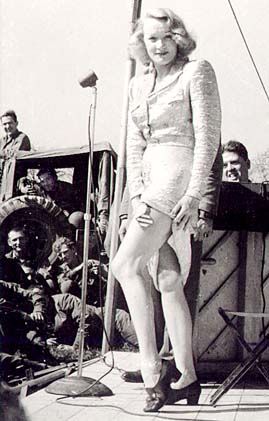 |
|
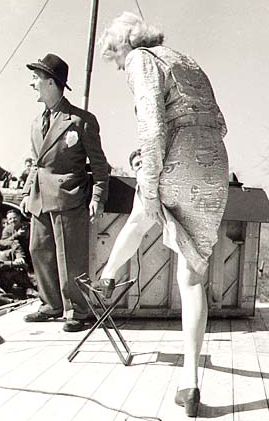 | |
|
Marlene
Dietrich entertaining soldiers of the 3rd ID http://www.warfoto.com |
Marlene
Dietrich showing her gams to soldiers of the 3rd ID http://www.warfoto.com | ||
Y DRYCH
BOX
8089
St Paul MN 55108
4 August 1995
I met Colonel Alfred J. Reese, Jr. selected by the National Welsh-American Foundation (NWAF) to receive their Foundation Heritage Medallion on October 21st 1995 about five years ago at a function sponsored by the Welsh Society of Philadelphia, and came to appreciate him as a person of integrity, a dedicated Welshman, and as an influential American.
Unbeknownst to either of us, Colonel Reese had a great impact on my life as one insignificant artilleryman in Europe over fifty years ago. Sometime early in 1944 we were issued a new artillery fuze much more effective than customary impact and time delay fuzes we had been using. This new "proximity" fuze used a RADAR type system to cause the shell to explode within about thirty feet of the ground, and was very effective against enemy personnel and vehicular equipment. Since meeting Colonel Reese I learned he was part of the Army Ordinance Corps team that developed this new fuze. Oddly enough, about forty years ago I had met one of the inventors of the proximity fuze, Dr. Alan Astin, former director of the National Bureau of Standards in conjunction with my activities with the New Jersey State Office of Weights and Measures.
However, Colonel Reese's service as an army logistician may have been far more important. It's been said, " an army marches on its stomach." If it is not properly supplied with equipment, spare parts, proper clothing, food/medicine, fuel and ammunition as required the old story "For lack of a nail the shoe was lost etc." will probably apply. Russian winters defeated Napoleon's army and the German army because neither army was equipped to withstand the cold harsh Russian winters. Although desperate measures were required, many allied soldiers suffered greatly during the Battle of the Hurtgen Forest and the Battle of the Bulge because they were sent into combat in summer clothing.
Colonel Reese well deserves this recognition by the NWAF and I hope to be on hand to applaud him.
Sincerely,
James
R Bird
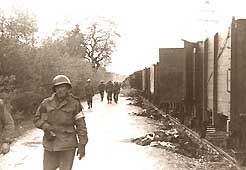 |
Dachau, Although it was many years ago, I recall the weather was blustery with snow flurries. When we arrived at the main camp (several satellite camps were also known as Dachau) we noticed a penetrating odor that I cannot now describe. I recall there was a railroad siding on which a train of 40 & 8 type railroad freight cars was parked. These cars contained bodies clad in black and white striped clothing, the side doors of the cars were open and piles of bodies also lay below the open doors alongside the track. Inside the camp I saw piles of clothing and shoes, apparently taken from the victims, and in rooms near the furnaces were naked bodies stacked like cordwood.
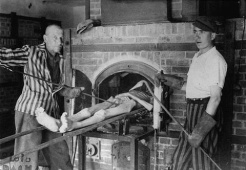 |
I recall seeing the ovens used to burn bodies and recollect there was still some partly consumed bodies in some of them. One of my buddies photographed many scenes there, and later provided us with copies. I do not have them now because I have reason to believe my mother destroyed them since they were beyond her belief. Within the past two years I did get copies of other pictures taken by Donald J. Madison, 122 N. Walnut St. PO Box 335, Toluca IL 61269 who served with I Co 157th Infantry Regiment, 45th Infantry Division.
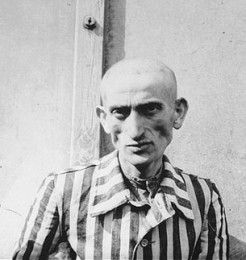 |
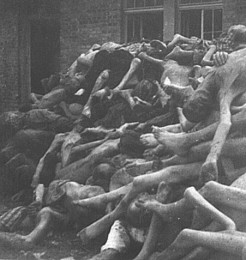 |
I have a faded recollection of seeing living prisoners wearing the same black and white stripped clothing, but the piles of dead bodies is the prominent feature of my memories of Dachau. Time erodes memories and it is not now possible to recollect my feelings, or remember the feelings of my buddies of this visit.
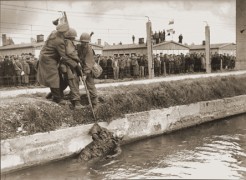 |
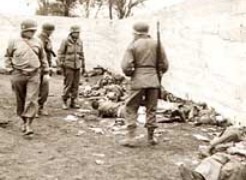 |
I do recall seeing a German soldier's body in one of the canals flowing through the camp. I recollect being told that he had been killed by prisoners, the body was lying on its back, stomach torn open with his entrails flowing downstream from the body. I also have a vague recollection of bodies of some German soldiers lying in the area.
I recollect this camp was liberated by members of the 45th Infantry Division and some from the 42nd Infantry Division; but do not know who was in charge when I visited this camp. But recently learned veterans of several units are vying for the honor(?) of 'liberating' this awful place.
Within the past year a controversy has surfaced because members of other units purport they were the 'liberators' of Dachau causing me to check reports and publications which convinced me that portions of the 45th Division Reconnaissance troop, the 157th Infantry Regiment and the 191st Tank Battalion were truly the main liberating force. And, offer the following documentation:
1.
The 45th DIVISION NEWS published May 13th 1945 has an extensive article by Bill
Barrett on the capture of Dachau by the 157th Infantry Regiment
2. TIME, May
28, 1945, in an article, MARK OF THE FIGHTING MAN, credits the 45th Division with
liberating Dachau.
3. The 45th DIVISION NEWS published June 10th 1945 sums
up division activities and reports the 157th Infantry Regiment captured Dachau.
4.
BEACHHEAD NEWS (started at Anzio), June 17th 1945 summed up 45th Division activities
and reported the 157th Infantry Regiment captured Dachau.
5. THE 45th DIVISION
ARTILLERY, a compilation of actions passed by SHAEF Field Censor and printed by
F. Bruckmann, Munich, Germany in June 1945. noted the division captured Dachau
on April 29th.
6. THE FIGHTING FORTY-FIFTH. Compiled and edited under the supervision
of the Historical Board by Leo V. Bishop, LT Col.; Frank J. Glasgow, Major; and
George A. Fisher, Major and published by the 45th Infantry Division in 1946. This
division history records on April 29th, "The 157th Infantry, with the 191st
Tank Battalion in support, captured the prison (Dachau) camp shortly afternoon."
7.
DACHAU, The Hour of the Avenger by Col. Howard A. Buechner (an eye witness account)
published in 1986 by Thunderbird Press, Matairie, LA. Dr. Buechner was a doctor
assigned to the 157th and documents this book lists both written and verbal statements
of soldiers who liberated Dachau.
8. Dachau and Its Liberation by B. G.. Felix
L. Sparks, retired published by the 45th Infantry Division Museum, Oklahoma City,
OK in January 1990. This is a personal report of Then Lt. Col. Sparks CO 3rd Bn
157th Infantry Regiment.
9. The Inspector General of the Seventh Army conducted
an investigation on 8 June 1945 and reported Dachau fell to the 157th Infantry
Regiment along with a small party of the 42nd Division.
10. I have personally
talked to two men who testify they entered Dachau with liberating forces on the
29th of April 1945, they are: The Reverend Alex Dryden who was a member of the
45th Division Reconnaissance Troop. He served at Bishop Eustice Prep School, Pennsauken
NJ 08109. The second person deleted at his request.
11. NEW YORK TIMES, 1 May
1945; article by Marguerite Higgens. "while a United States 45th Infantry
Division patrol was still fighting a way down through the SS barracks to the North
our jeep and two others from the 42nd Infantry drove into the camp enclosure through
the southern entrance."
[JULY 2005]
This field artilleryman of WWII thought ETO veterans would be interested in knowing
more about the 105mm field artillery guns used to directly support them so effectively.
Most WWII infantry division had three battalions of 105mm gun/howitzers and
one battalion of 155mm howitzers. Each battalion had three ‘firing batteries’
of four guns each, a headquarters battery and a service battery.
My comments
and recollections cover the towed split trailed gun/howitzer that could be used
to provide indirect and direct fires. Each gun was towed by a 6x6 open cab truck
with a ring mount over the assistant driver’s seat. This enabled us to mount
a .50 caliber machine gun which could be swung in all directions. These trucks
were equipped with a front-end mounted winch used on many occasions to move the
guns into position.
My A Battery 160th FA Bn, 45th Infantry [Thunderbird] Division was the first to land on the beach in the invasion of Sicily [10 July 1943] and was the first allied artillery unit to fire against the Germans in the European area.
99 44/100 percent of our firing was Indirectly controlled by forward observers attached to infantry units or air observation planes through a fire-direction center. My first recollection of direct fire against the Germans was during the battle of Salerno when German tanks approached us. At the end of this engagement we had three guns still working and only a few rounds of smoke shells and one or two armor piercing shells left in the battery. The second and last time we used direct fire was in our movement south of Nürnberg we fired on German trucks visible to us.
We used semi-fixed ammunition. The brass powder shell case contained seven powder charges packed in bags attached together with an easily breakable cord.
We had high explosive (HE) shells, various color smoke shells, white phosphorus (WP) also known as willy peter, and a few armor piercing shells.
The most frequently used used fuze was an impact/delay(.15 second) that would
be set causing the shell to explode on impact or after penetration. Time fuzes
were set with a wrench to cause the shell to burst in the air over enemy troops,
and proximity fuzes. This fuze was designed to burst about thirty above the ground.
My recollection is that it was 80% percent effective - that is eight out of ten
fuzes would cause the shell to burst at the proper hight. Sometimes at night we
would observe a shell burst at the apogee.
I thought proximity fuzes
were first used at Anzio but was mistaken.
I learned from the Aberdeen Ordnance Museum proximity fuzes were not issued to field artillery units in the ETO until December of 1944 since SHAEF was concerned that the Germans might retrieve dud rounds and reverse-engineer the fuze. However, we didn’t know it at the time, The Germans were already working on their own proximity fuze. However, once we had them they were frequently and effectively used against enemy troops in place of timed shell bursts. These fuzes were first available to the navy early because duds would land in the ocean. SHAEF withheld the fuzes from the field artillery until December 1944 because the army thought duds could be reverse engineered by the Germans.
I learned from Dr. William F. Atwater, Ph.D director of the U S Army Ordnance
Museum that the first proximity fuzes were issued to the navy in the Pacific area
and issued to army anti-aircraft units during the Battle of the Bulge, and then
to the field artillery after December 18th 1945 - WHAT A CHRISTMAS PRESENT THEY
WERE!
Dr, Atwater also revealed that the shells needed to fall fairly perpendicular
to the ground for best effect, and that this dictated special calculations by
fire control centers.
I later met two men involved in the development of the proximity fuze. Dr Alan Astin, former director of the National Bureau of Standards had a hand in developing a proximity fuze for non-rotating missiles, bombs and rockets. And, Colonel Alfred Reese, USA Ret. who as a sergeant ran the ammunition section of a detachment sent from Aberdeen Proving Ground to Fort Miles, DE, for one and half years test firing of the proximity fuze.
I wondered what the rated tube life was for a 105mm gun because when we left Anzio we thought our gun tubes looked like shot gun bores. Dr. Atwater told me the rated life was approximately 20,000 rounds. I doubt if we ever fired that many rounds through our guns (a lot had to do with powder charges used - the higher number of charges, the more wear on the tubes.) However, he did say many guns were replaced in the field because of cracks, blown seals etc.
When the Germans tried to push us off the Anzio Beachhead a vast number of shell were fired. A sister battalion to my 160th FA was the 158th FA Bn which expended nearly 27,000 rounds [2,200 per gun] supporting the 157th Infantry Regiment [later termed The Rock of Anzio] by Flint Whitlock who wrote a book of the same name. We were able to fire more shells than ordnance people thought possible by using a short lanyard on the trigger and load and firing at least five times before we had to let the recoil system return the gun to ‘battery position.’ We had stacks of prepared shells with three, four and five charges.
On numerous occasions throughout the war, we were part of Time-on-Target (TOT) fire-missions when several battalions of artillery, 105mms, 155mms, and heavier guns were programed to fire at predetermined times so that the first ‘load’ of shells would fall on a target simultaneously. This was a very effective move against enemy personnel.
When moving up through Southern France combat teams [infantry, artillery, armor and engineers] were established and provided with an air-OP observation plane. When a target was sighted we would be alerted, stop and set up two guns on each side of the road and proceed to fire as directed. When finished we hooked up again and moved further up the road.
The Battle of NORDWIND launched on 31 December 1944 by the Germans was Hitler’s last major offensive it was designed to split the American Third and Seventh Armies. On 1 January 1945 we fired a mission that dropped shells on our own troops. We later learned the error was caused because the fire-direction center had not calculated for a sudden drop in temperature the night before.
Information provided by Colonel Alfred Reese from They Never Knew what Hit Them, by Ralph B. Baldwin; Reynier Press, Naples. FL 1999. According to Baldwin, 22,000,000 proximity fuzes were produced through August 1945, 1,500,000 were fired against the enemy. In 1942 they cost $742.00 but that cost was reduced to $18.00 each in 1945. General Patton was quoted as saying, “The proximity fuze won the battle of the Bulge.”
I received my basic field artillery training at Ft. Bragg, NC. My first training was on an old French 75mm fixed ammunition gun left over from WWI. Then when assigned to the 141st Field Artillery Battalion, Louisiana National Guard had 155mm Schneider single trail units also used in WWI. Eventually, I was transferred to the 45th [Thunderbird] Infantry Division Artillery equipped with split trail 105mm gun/howitzers.
I survived all eight campaigns [more than five hundred days of combat] with the Thunderbirds and arrived back home with a Silver Star and two Purple Hearts.
About ten years ago [1995] I visited Aberdeen Proving Grounds with a small group of Marines who served in the Pacific during WWII. I had My picture taken next to a WWI French 75mm gun and Anzio Annie. Anzio Annie was one of two German 280mm smooth bore [the shells were manufactured with rifling] railway guns that were fired against us on the Anzio Beachhead.
I was privileged to talk to a small class of Marines being trained as artillery mechanics. One of the things I said opened their eyes wide - that when ‘the manure hit the fan’ during a battle like Anzio the rule book vanished. Firing range safety rules were ignored. Ammunition trucks would back up to well dug in gun pits and off-load 105mm ammunition like it was fire wood and get out of there in a hurry before being observed by the Germans and fired upon.
On April 27, 2005, two bus loads of Anzio Beachhead Veterans were hosted for lunch
at the Aberdeen Ordnance Museum by the base commander, Brig Gen. Vincent Boles.
We went there to have our pictures taken next to Anzio Annie now sitting on a
stretch of railroad tracks. I also met Col. Kone Brugh, ((Ret). Chairman) of the
Board of Directors of the Museum. In a letter, Dr. Wm. F. Atwater, PH. D, Director
of the Museum provided me with much needed information for this article.
last revision